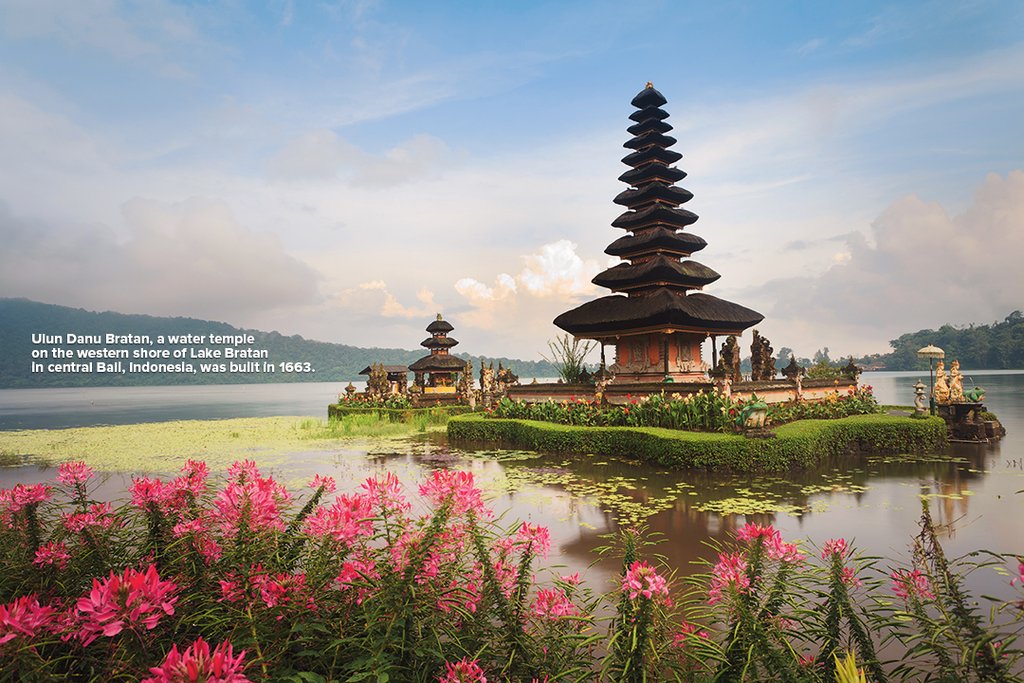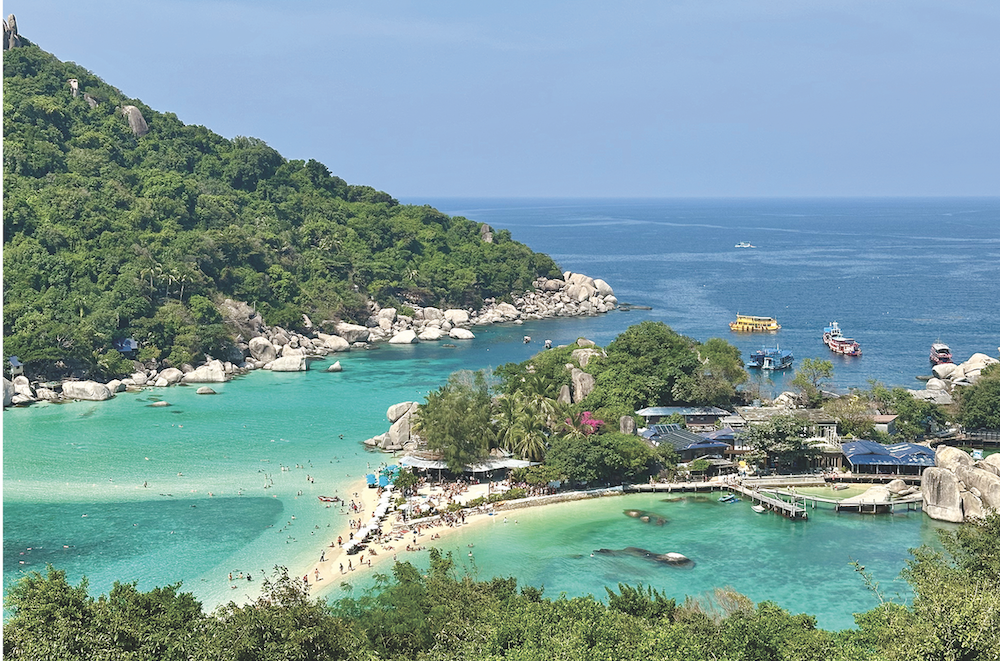THIS INDONESIAN ISLAND SEEMS TO CAST A SPELL ON SOME OF ITS VISITORS
By Michael Ryval
Driving along an empty road surrounded by dense forest in the northeast corner of Bali, we were jolted to a halt when our driver hit the brakes. Standing in the middle of the road was a middle-aged Balinese woman, frantically waving us down. She was carrying an assortment of flowers, banana-leaf basketry, and various trinkets. On our way to Pura Besakih, Bali’s “Mother of Temples,” my wife, Janet, and I weren’t prepared for this sort of encounter. What did she want?

I hesitated and then, retrieving my wallet from a back pocket, replied, “Fifty thousand.”
“One hundred thousand,” she insisted, pointing at my wallet.
“Take back your beads,” I told her, putting my wallet away.
“Stop!” she shouted and held up her hands. “Okay! Okay! Fifty thousand! I take.”
So we settled on the equivalent of five bucks and drove on with a few laughs to one of Bali’s most splendid temples.
“Is this really Bali?” I asked Made after pondering this curious mixture of ceremony and commerce in the middle of nowhere. “Yes, my friend!” he thumped the steering wheel and laughed. “Be happy. She gave you many blessings!”
Photos: iStock/MuYeeTing (1); Michael Ryval (2 to 4).
TRANQUIL BEAUTY
So she did. Halfway through our eight-day stay in Bali, an Indonesian island that is also a province of that country, we felt fortunate to be enjoying its tropical climate and lush landscape, the easygoing nature of the Balinese, and the great food.
Having travelled through many other countries, we concluded that there is little that matches the tranquility and beauty of Bali’s rolling green hills and the rice plantations that cover much of the southern part of the island. It’s equally beautiful in the hillier north, which is dominated by towering mountains such as Batukaru and Agung that look over a verdant landscape of farms that grow coffee, spices, pineapple, and vegetables and raise ducks and cattle.
And of course there are Bali’s beaches, such as Kuta and Sanur, both located on an isthmus just south of the province’s capital, Denpasar. Kuta, on the isthmus’s western side, is famous for great surfing and the dusk-to-dawn nightlife that attracts a younger crowd—mostly Australian. On the east side is Sanur, a quieter beach community that offers a leisurely pace, which we later came to appreciate.
It’s no wonder that Bali is such a popular destination: each year it attracts about three million people—almost 75 per cent of the island’s population of more than 4.2 million. However, even though Bali is just slightly larger than Prince Edward Island, it’s roomy enough that you don’t feel crowded. Just go a little off the beaten path and you’ll be enchanted by this tropical island eight degrees south of the equator where there are only two seasons—wet and dry—and the average daily temperature is 28°C (82.5°F).
Unlike the rest of Indonesia, Bali is overwhelmingly Hindu, which, combined with the fact that the island is surrounded by the 250 million Muslims who make up Indonesia’s majority, makes for an interesting ethnocultural mix. However, Balinese Hinduism is not the kind practised in India. Rather, it is a blend of Buddhism, introduced in the 6th century, and Hinduism, introduced 500 years later, combined with Javanese and ancient animist beliefs. It’s on display in towns and villages, where family compounds are adorned with carved stone shrines and monuments decorated with ceremonial baskets of flowers and offerings of food to the gods. Many such baskets are placed on the sidewalks in front of the compounds that house several generations of one family and are another distinctive aspect of Balinese life.
The communal nature of life on the island was apparent on our first full day in Ubud, our base in Bali, about an hour north of the international airport in Denpasar. As we set out after breakfast on a three-hour guided tour of the rice paddies on the outskirts of Ubud, the subject of large and highly ornate private temples within family compounds came up.
“Many families have their own temples, to honour their ancestors,” our guide, Gede, explained.
Showing honour is a way of life in Bali. As we walked through the rice fields, we could see small stone shrines dotted along the perimeter of the fields. Divided precisely into sections about 10 metres square (107.6 square feet), these are harvested by hand every four months, each yielding about 50 kilograms (110 lbs) of rice. In these fields we encountered women villagers bearing offerings, known as canang sari, of orange and red flowers artfully arranged in boxes made of green banana leaves. “They come here every day,” Gede told us, “to thank the goddess of rice for her help and to bring a good harvest.”
We noticed when we came to a small village that some family temples were a lot more ostentatious than others. In fact, some were larger than the homes that people lived in, and were decorated with huge statues of intimidating Hindu demigods that acted as guardians. Was it a case of keeping up with the Jones, Balinese style? Not really, Gede said somewhat diplomatically: “Each family honours their ancestors in their own way.”
Finally we stopped for a refreshing drink of coconut milk and lunch in a family compound in Laplanan, about three kilometres (two miles) north of Ubud. The compound was one of scores of similar compounds in a typical Balinese village.
By midday we were driven back to Hotel Tjampuhan, where we escaped the 33°C (91.5°F) afternoon heat and took a welcome dip in the spring-fed pool nestled into the side of the hill. As the days went by, it was a habit that we readily adopted.
TEMPLE TO TEMPLE

Early the next day, we caught a taxi to the Sacred Monkey Forest Sanctuary, on Monkey Forest Road in the southern part of Ubud. Scores of macaques, we were told, guard the three small temples in the middle of the rainforest. Since the temples were closed to visitors, we contented ourselves with a few laughs as we watched the macaques run freely and pounce, begging for food, on unsuspecting visitors.
As the day grew warmer, we wandered into town and visited the Taman Saraswati temple, on Ubud’s main road, Jalan Raya Ubud. The temple is notable for its carvings of Dewi Saraswati, the goddess of wisdom and the arts. A natural spring feeds the pond in the front of the temple and is covered with beautiful lotus flowers. That evening, we had dinner in the adjacent Cafe Lotus, where we watched highly stylized dances, accompanied by a full gamelan orchestra, in front of the temple, which was lit for the occasion.
The following day, we ventured north of Ubud and visited Gunung Kawi Temple and its 1,000-year-old monuments. These stand at the foot of more than 270 stairs, which proved a challenge on the return trip to the parking lot. But it’s worth the hike because along the way you will pass lovely terraced rice fields, and then you finally come face to face with the candi, or shrines, which are cut from the rock and stand about eight meters (26 feet) high. The candi are said to be memorials to 11th-century Balinese royalty, although this claim is not entirely certain. What is certain is the calm peaceful atmosphere and the surprising lack of tourists.
We found the opposite at Tirta Empul (which roughly translates into “water emerging from the land”), a water temple that features a spring that was discovered in the 10th century and is believed to have magical healing powers. Although we couldn’t see the source of the spring because it’s inside the temple, about 20 people, including several Westerners, plunged into the bathing pool outside the temple walls and immersed themselves in the cool waters. Some looked to be in a trance and dazed by the experience. Fortunately, we visited in the morning—we would have encountered large crowds after midday.
Far grander is Pura Besakih, a huge complex of 23 temples on the slopes of Mount Agung, about an hour’s drive from Ubud. The largest and most important temple is Penataran Agung, which is built on six levels of a terraced hill. The temple is approached via a very steep set of stairs leading to a split gateway named Candi Bentar. Beyond that is the gateway to a second courtyard. While tourists aren’t allowed inside the temple itself—and not even a guide can get access for foreigners—we could see very well by peeking over a low wall that circumscribed the main complex. The distinctive architecture of the multi-tiered spires loomed over the hillside as delicate kitelike strings dangled from the tops.
A SPELL?
Bali is not only about temples.
One afternoon, we hired a driver who took us to Munduk, a mountain retreat about 45 kilometres (28 miles) north of Ubud, which we sought as a change of pace from the busy town. There, following a sudden midday thunderstorm, we marvelled at the intensely green rice fields—each reflecting a different shade of green, the likes of which we hadn’t imagined existed—that stretched to the horizon. From the balcony of our cabin at Puri Lumbung Cottages, we watched the mist drape itself over those fields. Thanks to being at an elevation of almost 800 metres (2,625 feet), we also enjoyed a view of the Bali Sea, almost 10 kilometres (6.2 miles) away to the north.

We spent the mornings sightseeing. Once we walked about a kilometre to Villa Bebek, the home office of Made Wijaya, a very successful landscape architect who hails from Australia and is better known as Michael White. Entrance is free to the villa’s lovely garden (featured on Monty Don’s TV documentary-series Around the World in 80 Gardens), which represents one man’s vision of a tropical garden, with unusual stone statuary and calm pools surrounded by a wide array of plants.
Another morning we took a taxi to Bali Orchid Garden, on the northern fringe of Sanur. This is a work of love by David Dowd, a former New Zealander who, with his wife, Dorothy, settled in Bali in 1989 and never looked back. The garden has a collection of 750 orchids, including more than 30 unique to the island. (Admission costs about $10 per person.)
Bali’s charm and habit of keeping some people from leaving was evident in a visit to Le Mayeur Museum, also in Sanur’s northern outskirts. Adrian-Jean Le Mayeur de Merpres was a Belgian painter who came to Bali in 1932 for a short visit—and stayed for 26 years. Infatuated with a beautiful 15-year-old dancer named Ni Pollok who became his model and inspiration, Le Mayeur stayed on, marrying the young woman when she was 18. In 1958, illness forced him to return to Belgium for medical treatment, and he died there. Now the couple’s home in Sanur is open to visitors, who can see many Balinese artifacts as well as a selection of 80 paintings that are reminiscent of the work of another European—Paul Gauguin. An elegant sculpture of the couple stands next to a pool that is surrounded by tropical plants.
As we left the museum on a gloriously hot and sunny day—and returned to our hotel for a last afternoon relaxing by the tropical-themed pool— one thought crossed our minds: the beauty of Bali casts an unusual spell. Perhaps it’s helped along by some blessings—with or without the wooden beads and dabs of rice? Certainly, for the few who succumb, a visit can turn into a stay that lasts a lifetime.
IF YOU GO:
|







